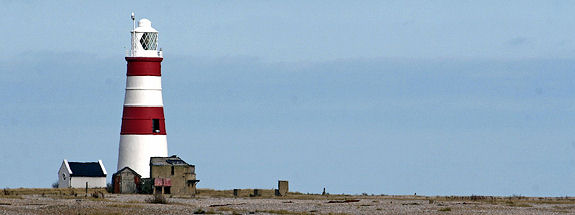
Orford Ness is a 21 km (13 miles) long shingle spit on the Suffolk coast, linked to the mainland at Aldeburgh and stretching along the coast to Orford and down to North Wier Point, opposite Shingle Street. It is divided from the mainland by the River Alde, and was formed by longshore drift along the coast. The material of the spit comes from places further north, such as Dunwich. Near the middle point of its length, at the foreland point or 'Ness', stands the Orfordness lighthouse.
The swift tides, shifting sand banks and shoals in the area present a significant danger to shipping - on one night alone in 1627, thirty-two ships were cast up on Orfordness with few survivor s. In February, 1634 John Meldrum was granted a patent to build two temporary lights between Sizewell Bank and Aldeburgh Napes. These lights were soon disposed of by Meldrum, in favour of those he had at North and South Forelands. Meldrum's successor at Orfordness was Alderman Gore who, under a further patent granted during the reign of Charles II, constructed two timber towers to indicate a safe passage through the narrow gap between the Sizewell Bank and Aldeburgh Napes.
Sir Edward Turnour was the next owner and he strengthened his position by buying outright the land on which the lighthouse stood and also a large area of Lantern Marshes to give him access. After his death in 1676 his son, also named Edward became the owner. The lights were badly maintained at this time and he had many complaints from the masters of vessels passing the light.
In 1707, Britain was at war with France. On June 23rd the Orfordness Lighthouses were attacked by a French Privateer who severely damaged a lantern and stole various goods, including the keeper's beds. The lighthouses came into the ownership of Henry Grey in 1720 who replaced the wooden lighthouses with brick towers at a cost of £1,180. In 1792, Lord Braybrooke, who was the owner at this time, had a new brick tower built much further back which became the great light and the previous great light then became the small light. It is this tower, built in 1792 which remains to this day. In 1836 under an Act of Parliament which gave Trinity House compulsory powers to levy out the private individuals who owned lighthouses, Trinity House paid the third Lord Braybrooke £13,414 for Orfordness Lighthouse. In 1888 major alterations took place at the great light or high light as it was now known. The light was made occulting and red and green shades were fitted to form sector lights.
Further alterations were made in 1914 when a new revolving lens was installed, it is this lens which is still in operation. Three vertical circular lenses are mounted on a circular platform which floats on a trough of mercury. The lens revolves around the lamp at a speed which appears as a flash every five seconds. At the same time as this light was installed another light was brought into operation half way up the tower. This is the sector light which is a fixed light showing through red and green windows facing south east and a red window facing north east. These lenses and all other lenses fitted over the years were installed by the firm of Stone-Chance.
In 1959 the lighthouse was converted to electric power and the dwellings, which were attached on either side of the tower for the keepers, were demolished. A standby generator was then installed, followed by remote control equipment. Time switches came into operation and on 6th July 1964 the station became fully automatic and under remote control from the Trinity House Depot at Harwich. In September 1965, the keepers were withdrawn. At this time the main navigation light was a 3KW 100V filament lamp. Recently new equipment has been installed and the lamp is now a 1KW 240V Mercury Vapour Discharge lamp.
In May 2010, Trinity House announced that it would be closing Orford Ness lighthouse, although no date has been set. The organisation manages its East Anglian lighthouses (Cromer, Lowestoft, Southwold and Orford Ness), buoys, beacons and DGPS (Differential Global positioning) from its station at Harwich; the range of Southwold Lighthouse just up the coast will be increased by using modern LED lighting.
In the 1930's Orford Ness was the site of the first purpose built experiments on the defence system that would later be known as radar. Having proved the technology on Orford Ness Robert Watson-Watt and his team moved to nearby Bawdsey Manor and developed the Chain Home radar system in time for its vital role in the Battle of Britain. The site is now a nature reserve managed by the National Trust, though access is strictly controlled to protect the fragile habitats and due to a residual danger to the public from the site's former use by the military .
By road: Orford Quay is 16 km east of A 12
By rail: Wickham Market Station is 13 km away
By water: Via the National Trust ferry from Orford Quay on designated open days

Bowen, J.P., British Lighthouses, British Council, ASIN: B001A8HS24 (1947)
Denton, A. & Leach, Nicholas, Lighthouses of England and Wales: A Complete Guide, Landmark Publishing, ISBN-10: 1843063190 (2007)
Hague, Douglas and Christie, Rosemary, Lighthouses, Their Architecture, History and Archaeology, Gomer Press, ISBN-0850883245(1975)
Naish, John, Seamarks, Their History and Development Adlard Coles Nautical, ISBN-10: 0540073091 (1985)
Nicholson, Christopher, Rock lighthouses of Britain; The end of an era?, Whittles Publishing, ISBN 1870325419. (1995)
Payton, Charles, Lighthouses: Towers of the Sea, National Trust Books, ISBN-10: 1905400128 (2006)
Woodman, Richard & Wilson, Jane, The Lighthouses of Trinity House, ISBN-10: 190405000X (2002)
National Trust - Orford Ness
Trinity House - Orfordness Lighthouse